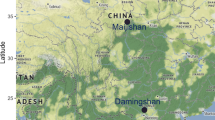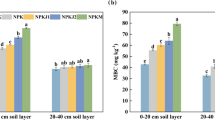Abstract
The Venezuelan oil industry has been develo** afforestation plans in savannas to create “CO2 compensation forests” to offset emissions from its activities. Acacia mangium is a pilot species used for this purpose. This study aimed to compare the changes in soil C fractions, nutrient stocks and microbial ecophysiological indices between savanna and 10-year-old A. mangium forest. Soil samples were collected from A, Bt1, and Bt2 horizons in both ecosystems. Soil C fractions (i.e., total, soluble, microbial, light, and heavy fractions), nutrient stocks (i.e., exchangeable Ca, Mg, K, and Al, available P, and total N), and microbial ecophysiological indices (i.e., metabolic quotient, C mineralization microbial coefficient, and basal respiration) were analyzed between savanna and 10-year-old A. mangium forest. A. mangium forest had higher total C in the litter and organic matter heavy fraction, greater microbial biomass, total N, and exchangeable aluminum, and lower phosphorus and pH compared to the savanna. Afforestation increased soil microbial biomass, but basal respiration and microbial coefficient were not different. Metabolic coefficient, mineralization coefficient, and metabolic efficiency coefficient were lower in the Acacia forest than in the savanna. After 10 years, afforestation of savannas with A. mangium fulfills the purpose of promoting C sequestration, particularly within more stable fractions (i.e., carbon in heavy fraction) and labile forms of carbon microbial biomass. Furthermore, the N concentration is higher in Acacia forests due to the N-fixing ability of this species. However, acidity and exchangeable Al were higher while P availability was lower. Ecophysiological indices revealed a more efficient use of C by microorganisms and a less stressful condition under afforestation that could be related to a better quality of organic matter with a higher N concentration. More detailed studies on soil quality and other ecosystem indicators must be conducted to unveil the impacts of afforestation.


Similar content being viewed by others
References
Alef K, Nannipieri P (1995) Methods in applied soil microbiology and biochemistry. Academic Press, London. https://doi.org/10.1016/B978-0-12-513840-6.X5014-9
Anderson JM, Ingram JSI (1993) Tropical soil biology and fertility: a handbook of methods. CAB International, Wallingford
Bernhard-Reversat F (1993) Dynamics of litter and organic matter at the fast-growing tree plantations on sandy ferrallitic soils (Congo). Acta Oecol 14:179–195
D’Amore D, Kane E (2021) Climate change and forest soil carbon. In: Climate Change Resource Centre. USDA, Forest Service https://www.fs.usda.gov/ccrc/topics-/forest-soil-carbon. Accessed in September 22, 2021
Dilly O, Winter K, Lang A, Munch JC (2001) Energetic eco-physiology of the soil microbiota in two landscapes of southern and northern Germany. J Plant Nutr Soil Sci 164:407–413. https://doi.org/10.1002/1522-2624(200108)164:4<407::AID-JPLN407>3.0.CO;2-9
FAO (2015) World reference base for soil resource 2014. In: World Soil Resources Reports 106. Food and Agriculture Organization of the United Nations, Rome
Galiana A, Balle P, N’Guessan Kanga A, Domenach AM (2002) Nitrogen fixation estimated by the 15N natural abundance method in Acacia mangium Willd. inoculated with Bradyrhizobium sp. and grown in silvicultural conditions. Soil Biol Biochem 34:251–262. https://doi.org/10.1016/S0038-0717(01)00179-1
Giweta M (2020) Role of litter production and its decomposition, and factors affecting the processes in a tropical forest ecosystem: a review. J Ecol Environ. 44. https://doi.org/10.1186/s41610-020-0151-2
Grace J, San José J, Meir P, Miranda HS, Montes RA (2006) Productivity and carbon fluxes of tropical savannas. J Biogeogr 33:387–400. https://doi.org/10.1111/j.1365-2699.2005.01448.x
Heringer G, Bueno ML, Meira-Neto JAA, Matos FAR, Neri AV (2019) Can Acacia man---gium and Acacia auriculiformis hinder restoration efforts in the Brazilian Atlantic Forest under current and future climate conditions? Biol Invasions. 21:2949–2962. https://doi.org/10.1007/s10530-019-02024-7
Hernández-Valencia I, Bautis M (2005) Cambios en el contenido de fósforo en el suelo superficial por la conversión de sabana en pinares. Bioagro 17:69–78
Hernández-Valencia I, López-Hernández D (1997) Flujo de materia orgánica en el estrato herbáceo de una sabana de Trachypogon sometida a quema y pastoreo. Acta Biol Venez 17:23–33
Hernández-Valencia I, López-Hernández D (2002) Pérdida de nutrimentos por quema de vegetación en una sabana de Trachypogon. Rev Biol Trop 50:1013–1019
Huynh CV, Nguyenb PT, Phamc TG, Nguyenb HT, Nguyenb MTH, Tran PT (2022) Evaluation of soil organic matter content under topographic influences in agroforestry ecosystems: a study in Central Vietnam. Eurasian Soil Sci. 55:1041–1051. https://doi.org/10.1134/S106422932208004X
Kelty MJ (2006) The role of species mixtures in plantation forestry. For Ecol Manag. 233:195–204. https://doi.org/10.1016/j.foreco.2006.05.011
Kou-Giesbretch S, Menge D (2019) Nitrogen-fixing trees could exacerbate climate change under elevated nitrogen deposition. Nature Commun. 10:1493. https://doi.org/10.1038/s41467-019-09424-2
Koutika LS, Richardson DM (2019) Acacia mangium Willd: benefits and threats associated with its increasing use around the world. For Ecosyst 6:1–13. https://doi.org/10.1186/s40663-019-0159-1
Lee KL, Ong KH, King PJH, Chubo KJ, Su DSA (2015) Stand productivity, carbon content and soil nutrients in different stand ages of Acacia mangium in Sarawak, Malaysia. Turk J Agric For 39:154–161. https://doi.org/10.3906/tar-1404-20
Levan C, Buihman H, Oluwasanmi Tope BO, Xu X, Nguyenminh T, Lak C, Nebiyou L, Wang J, Buivan T (2020) Biomass and carbon storage in an age-sequence of Acacia mangium plantation forest in southeastern region, Vietnam. For Syst 29:65–80. https://doi.org/10.5424/fs/2020292-16685
López-Hernández D, Hernández-Valencia I (2009) Nutritional aspects in Trachypogon savannas as related to nitrogen and phosphorus cycling. In: Del Claro K, Oliveira PS, Rico Gray V (eds) Tropical Biology and Conservation Management - Volume X: Savanna Ecosystems. Eolss Publishers Co. Ltd. Oxford, Unesco, pp 1–27
Macedo MO, Resende AS, García PC, Boddey RM, Jantalia CP, Urquiaga S, Campello EFC, Franco AA (2008) Changes in soil C and N stocks and nutrients dynamics 13 years after recovery of degraded land using leguminous nitrogen-fixing trees. For. Ecol. Manag 255:1516–1524. https://doi.org/10.1016/j.foreco.2007.11.007
Matali S, Metali F (2015) Selected soil physico-chemical properties in the Acacia mangium plantation and the adjacent heath forest at Andulau Forest Reserve. Malaysian J Soil Sci 19:45–58
Medina E, Mendoza A, Montes R (1978) Nutrient balance and organic matter production in the Trachypogon savannas of Venezuela. Trop Agric 55:243–253
Odum E (1969) The strategy of ecosystem development. Science 164:262–270. https://doi.org/10.1126/science.164.3877.262
Oliveira Simŏes SM, Zilli JE, Gomes Costa MC, Tonini H, De Carvalho BF (2010) Carbono orgânico e biomassa microbiana do solo em plantios de Acacia mangium no cerrado de Roraima. Acta Amaz 40:23–30. https://doi.org/10.1590/S0044-59672010000100003
Pereira APA, Zagatto MRG, Brandani CB, Mescolotti DL, Cotta SR, Gonçalves JLM, Cardoso EJBN (2018) Acacia changes microbial indicators and increases C and N in soil organic fractions in intercropped Eucalyptus plantations. Front. Microbiol. 9:655. https://doi.org/10.3389/fmicb.2018.00655
Rachid CTCC, Balieiro FC, Peixoto RS, Pinheiro YAS, Piccolo MC, Chaer GM (2013) Mixed plantations can promote microbial integration and soil nitrate increases with changes in the N cycling genes. Soil Biol Biochem 6:146–153. https://doi.org/10.1016/j.soilbio.2013.07.005
Reimer M, Hartmann TE, Oelofse M, Magid J, Bűnemann E, Mőller K (2020) Reliance on biological nitrogen fixation depletes soil phosphorus and potassium reserves. Nutr Cycl Agroecosyst. 118:273–291. https://doi.org/10.1007/s10705-020-10101-w
Resh SC, Binkley D, Parrotta JA (2002) Greater soil carbon sequestration under nitrogen-fixing trees compared with eucalyptus species. Ecosystems 5:217–231. https://doi.org/10.1007/s10021-001-0067-3
Ribet J, Drevon JJ (1996) The phosphorus requirement of N-fixing and urea-fed Acacia mangium. New Phytol. 132:383–390. https://doi.org/10.1111/j.1469-8137.1996.tb01858.x
Sang PM, Lamb D, Bonner M, Schmidt S (2013) Carbon sequestration and soil fertility of tropical tree plantations and secondary forest established on degraded land. Plant Soil 362:187–200. https://doi.org/10.1007/s11104-012-1281-9
Rondón M, Acevedo D, Hernández RM, Rubiano Y, Rivera M, Amezquita E, Romero M, Sarmiento L, Ayarza M, Barrios E, Rao I (2006) Carbon sequestration potential of the neotropical savanna of Colombia and Venezuela. In: Lal R, Cerri C, Bernoux M, Etchevers J, Pellegrino C (eds) Carbon sequestration in soils of Latin America. The Haworth Press Inc, New York, pp 213–243
USDA (2014) Keys to soil taxonomy. Natural Resource Conservation Service. USDA, Washington
Vance ED, Brookes PC, Jenkinson DS (1987) An extraction method for measuring soil microbial biomass C. Soil Biol Biochem 19:703–707. https://doi.org/10.1016/0038-0717(87)90052-6
Weil RR, Brady NC (2015) The nature and properties of soils. Pearson. Columbus, USA
Yamashita OS, Ohata S, Hardjono A (2008) Soil changes induced by Acacia mangium plantation establishment: comparison with secondary forest and Imperata cylindrical grassland soils in South Sumatra, Indonesia. For Ecol Manag. 254:362–370. https://doi.org/10.1016/j.foreco.2007.08.012
Yang L, Liu N, Ren H, Wang J (2009) Facilitation by two exotic Acacia: Acacia auriculiformis and Acacia mangium as nurse plants in south China. For Ecol. Manag 257:1786–1793. https://doi.org/10.1016/j.foreco.2009.01.033
Zhang H, Duan HB, Song MW, Guan DS (2018) The dynamics of carbon accumulation in Eucalyptus and Acacia plantations in the Pearl River delta region. Ann For Sci. 75:1–13. https://doi.org/10.1007/s13595-018-0717-7
Acknowledgements
The authors would like to thank Jordi Sardans and Josep Peñuelas Reixach from the Global Ecology Unit CREAF-CSIC-UAB (Universitat Autònoma de Barcelona, Spain) and Diana Papoulias and Denise Mager for their valuable comments on the manuscript and translation. Ismael Hernández-Valencia would like to thank the Carolina Foundation (Spain) for the financial support for the fellowship at the Global Change Unit of the Autonomous University of Barcelona. This research was funded by FONACIT (Venezuela), project No MCTI 2013001877.
Author information
Authors and Affiliations
Contributions
Ismael Hernández-Valencia and Lenny Romero contributed to the study’s conception and design. All authors performed the material preparation and data collection and analysis. The first draft of the manuscript was written by Ismael Hernández-Valencia and all authors commented on the previous versions. All authors read and approved the final version of the manuscript.
Corresponding author
Ethics declarations
Competing Interests
The authors declare no competing interests.
Additional information
Publisher’s note
Springer Nature remains neutral with regard to jurisdictional claims in published maps and institutional affiliations.
Rights and permissions
Springer Nature or its licensor (e.g. a society or other partner) holds exclusive rights to this article under a publishing agreement with the author(s) or other rightsholder(s); author self-archiving of the accepted manuscript version of this article is solely governed by the terms of such publishing agreement and applicable law.
About this article
Cite this article
Hernández-Valencia, I., Romero, L. & Figueroa, A.Z. Changes in Soil Carbon Fractions in a Tropical Savanna Afforested with Acacia mangium. J Soil Sci Plant Nutr 23, 2732–2740 (2023). https://doi.org/10.1007/s42729-023-01230-6
Received:
Accepted:
Published:
Issue Date:
DOI: https://doi.org/10.1007/s42729-023-01230-6




